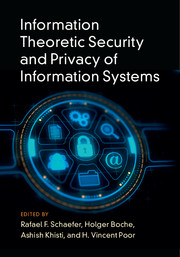Book contents
- Frontmatter
- Contents
- List of Contributors
- Preface
- Part I Theoretical Foundations
- Part II Secure Communication
- Part III Secret Key Generation and Authentication
- Part IV Data Systems and Related Applications
- 15 Information Theoretic Analysis of the Performance of Biometric Authentication Systems
- 16 Joint Privacy and Security of Multiple Biometric Systems
- 17 Information Theoretic Approaches to Privacy-Preserving Information Access and Dissemination
- 18 Privacy in the Smart Grid: Information, Control, and Games
- 19 Security in Distributed Storage Systems
- Index
- References
18 - Privacy in the Smart Grid: Information, Control, and Games
from Part IV - Data Systems and Related Applications
Published online by Cambridge University Press: 28 June 2017
- Frontmatter
- Contents
- List of Contributors
- Preface
- Part I Theoretical Foundations
- Part II Secure Communication
- Part III Secret Key Generation and Authentication
- Part IV Data Systems and Related Applications
- 15 Information Theoretic Analysis of the Performance of Biometric Authentication Systems
- 16 Joint Privacy and Security of Multiple Biometric Systems
- 17 Information Theoretic Approaches to Privacy-Preserving Information Access and Dissemination
- 18 Privacy in the Smart Grid: Information, Control, and Games
- 19 Security in Distributed Storage Systems
- Index
- References
Summary
The deployment of advanced cyber infrastructure in the electricity grid, leading to the so-called smart grid, introduces concerns about the privacy of the parties interconnected by the grid. In this chapter, the roles of information, control, and game theories in quantifying and exploring such privacy issues are examined, primarily in the context of smart grid communications. Absolute privacy is generally not desirable in such applications, but rather the tradeoff between the privacy of data and its usefulness, or utility, is of concern. An information theoretic setting is used to characterize the optimal such tradeoff in a general context, and this setting is then applied to two problems arising in smart grid: smart meter privacy, in which control theory also plays a role when storage is introduced into the system; and competitive privacy, in which each of a group of multiple grid actors seeks to optimize its individual privacy–utility tradeoff while interacting with the other actors in information exchange, a setting that can be examined using game theory.
Introduction
The hierarchical, centralized, electricity grid is being transformed into a cyber-physical system. This transformation involves the introduction of sensors, meters, controls, and communication networks [1], in order to allow for greater end-point participation in the management of the grid. In particular, these developments will allow for demand-side participation in grid management, better integration of renewables and storage into the grid, etc., in order to create a more efficient, sustainable energy infrastructure. A key issue that arises when cyber capability is introduced into a system is privacy. This chapter will address this issue, first in a general setting, and then in the context of some particular problems arising in smart grid.
In considering this problem, we will see that information theory, control theory, and game theory all have roles to play in helping to understand the issue of privacy in the smart grid. In particular, we will first describe a general formalism for privacy, based on an information theoretic formulation. Then we will discuss the application of this formalism in two different settings arising in the smart grid.
- Type
- Chapter
- Information
- Publisher: Cambridge University PressPrint publication year: 2017



